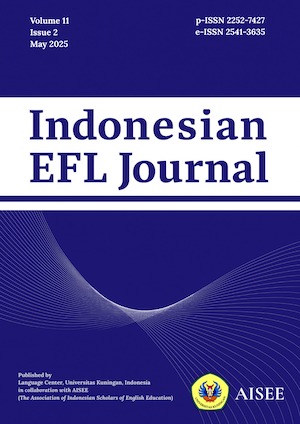THE USE OF PRAAT IN LEARNING ENGLISH DEBATE IN INDONESIAN EFL CLASSROOM
Abstract
This study aims to analyze the elements of suprasegmental sound in English debates consisting of stress and intonation by using the PRAAT computer program and students' perceptions toward the use of PRAAT in learning English debate. The data of this study were taken from the practice of debate in the General English class which is a compulsory course in Universitas Kuningan. A total of 30 students from one class of General English were involved in this study. The method used is a mixed method. Several instruments were used to collect data including observation and documentation for qualitative data, and questionnaires for quantitative data. PRAAT program version 6.0.33 was used to analyze the stress and intonation patterns, while questionnaire was used to determine students’ perceptions toward the use of PRAAT in mastering English debate. The results showed that the use of intonation and stress can affect the meaning of speech, especially in debate. Furthermore, students gave a positive response to the use of the PRAAT application in understanding the correct intonation patterns and pressure in speaking English.
Keywords: PRAAT; debate; EFL classroom
References
Abidin, Y. Z. (2013). Pengantar retorika. Bandung: Pustaka Setia.
Afriani, S. H. (2015). Analisis uji persepsi: Intonasi Kalimat Perintah Bahasa Indonesia oleh Penutur Bahasa Jepang. Tamaddun Vol. XV, No. 1/Januari – Juni 2015
Alwi, H., S. Darjowjidojo, H. Lapoliwa, & A.M. Moeliono. (2003). Tata bahasa baku bahasa Indonesia. Jakarta: Balai Pustaka.
Chaer, A. (2013). Fonologi bahasa Indonesia. Jakarta: PT Rineka Cipta.
Christodoulides, G. (2014). Praaline: Integrating tools for speech corpus research. In Proceedings of the 9th International Conference on Language Resources and Evaluation, Reykjavik, Iceland.
Davletcharova, A., et al. (2015). Detection and analysis of emotion from
speech signal. Procedia Computer Science, vol. 58, pp. 91-96, 2015,
doi:10.1016/j.procs.2015.08.032
Dominguez, M., Latorre, I., Farrus, M., Filba, J. C., (2016). Praat on the Web: An Upgrade of Praat for Semi-Automatic Speech Annotation. Proceedings of COLING 2016, the 26th International Conference on Computational Linguistics: System Demonstrations, pages 218–222, Osaka, Japan, December 11-17 2016.
Gorjian, B., Hayati, A., & Pourkhoni, P. (2013). Using Praat Software in teaching prosodic features to EFL learners. Procedia - Social and Behavioral Sciences 84 (2013) 34 – 40
Hart, J., Collier, R., & Cohen, A. (1990). A Perceptual study of intonation. Cambridge: Cambridge University Press.
Hayati, A.M. (2005). Computer and Language Teaching. Asian EFL Journal, 4, 21-28.
Joaquin, A.D. (2009). Drill, baby, drill: Exploring a Neurobiological Basis
for the Teaching of Segmentals in the ESL/EFL Classroom. Teachers Articles: volume 39 article 2.
Kridalaksana, H. (2009). Kamus linguistik edisi keempat. Jakarta: PT Gramedia Pustaka Utama.
Ladefoged, P. (2005). Vowels and consonants: an introduction to the sounds of languages. Second edition. Malden, Mass. & Oxford: Blackwell.
Magdin, M., Sulka, T., Tomanova, J., & Vozar, M. (2019). Voice analysis using PRAAT software and classification of user emotional state. International Journal of Interactive Multimedia and Artificial Intelligence, Vol. 5, No. 6
Marsono. (1999). Fonetik. Yogyakarta: Gadjah Mada University.
Mathew, I. (2005). Errors in pronunciation by learners of English as foreign language whose first language are Indonesia, Gayo and Acehnese. MONASH University Linguistic
paper 2005. Vol.3 number 2.
Miles, M. B. & Huberman, A. M. (1992). Analisis data kualitatif. Jakarta: Universitas Indonesia
Muslich, M. (2008). Fonologi bahasa Indonesia tinjauan deskriptif sistem bunyi bahasa Indonesia. Jakarta: Bumi Aksara.
Nespor, M. & Vogel, I. (2007). Prosodic phonology with a new foreword 2nd. Berlin: Mouton.
Nunan, D. (1993). Research method in language learning. Cambridge: Cambridge University Press.
Octavia, W. (2018). Penamaan bunyi segmental dan suprasegmental pada pedagang keliling. Jurnal Bahasa Lingua Scientia, Vol. 10, No. 1, Juni 2018
Simpson, A. P. (2012). The first and second harmonics should not be used to measure breathiness in male and female voices. Journal of Phonetics, 40(3):477–490
Stake, R.E. (2010). Qualitative research: studying how things work. New York: The Guilford Press
Styler, W. (2017). Using praat for linguistics research. Creative Commons Attribution-ShareAlike 3.0 Unported License
Styler, W. (2017). On the acoustical features of vowel nasality in English and French. The Journal of the Acoustical Society of America, 142(4):2469–2482
Truesdale, D. M. and M. D. Pell. (2018). The sound of passion and indifference. Speech Communication, vol. 99, pp. 124-134. 2018, doi:10.1016/j.specom.2018.03.007
Van, H., Vincent, J., & Judith, H. (2001). Temporal distribution of interrogativity marker in Dutch: A Perceptual study” In Gussenhoven, Carlos, T. Rietveld, and N. Warner (eds.). (2001). Papers in Laboratory Phonology VIII. Cambridge: Cambridge University Press.
Verhaar, J. W. M. (2010). Asas-ssas linguistik umum. Yogyakarta: Gadjah Mada University Press.
Wulandari, I., Rodliyah, I., & Fatimah. (2016). Using PRAAT for analysing segmental features of speech produced by the students of English study program of Universitas Brawijaya. ELTICS Journal, Vol. 3, 2016. ISSN : 2407-0742 (page 14-25)
Yusuf, S. (1998). Fonetik dan Fonologi. Jakarta: Gramedia Pustaka Utama.









